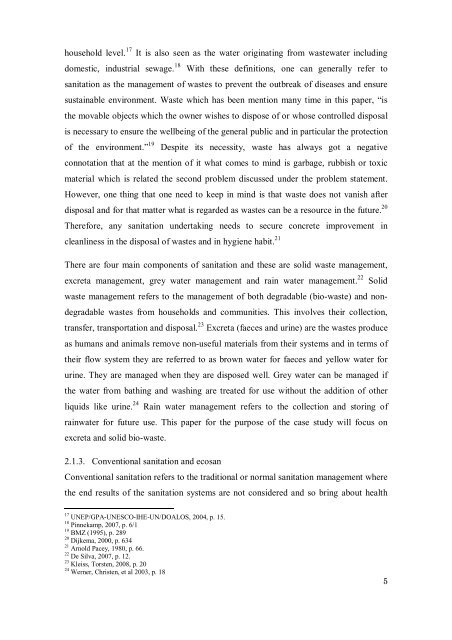A QUANTITATIVE APPROACH TO PREDICT ... - SuSanA
A QUANTITATIVE APPROACH TO PREDICT ... - SuSanA
A QUANTITATIVE APPROACH TO PREDICT ... - SuSanA
Create successful ePaper yourself
Turn your PDF publications into a flip-book with our unique Google optimized e-Paper software.
household level. 17 It is also seen as the water originating from wastewater including<br />
domestic, industrial sewage. 18 With these definitions, one can generally refer to<br />
sanitation as the management of wastes to prevent the outbreak of diseases and ensure<br />
sustainable environment. Waste which has been mention many time in this paper, “is<br />
the movable objects which the owner wishes to dispose of or whose controlled disposal<br />
is necessary to ensure the wellbeing of the general public and in particular the protection<br />
of the environment.” 19 Despite its necessity, waste has always got a negative<br />
connotation that at the mention of it what comes to mind is garbage, rubbish or toxic<br />
material which is related the second problem discussed under the problem statement.<br />
However, one thing that one need to keep in mind is that waste does not vanish after<br />
disposal and for that matter what is regarded as wastes can be a resource in the future. 20<br />
Therefore, any sanitation undertaking needs to secure concrete improvement in<br />
cleanliness in the disposal of wastes and in hygiene habit. 21<br />
There are four main components of sanitation and these are solid waste management,<br />
excreta management, grey water management and rain water management. 22 Solid<br />
waste management refers to the management of both degradable (bio-waste) and nondegradable<br />
wastes from households and communities. This involves their collection,<br />
transfer, transportation and disposal. 23 Excreta (faeces and urine) are the wastes produce<br />
as humans and animals remove non-useful materials from their systems and in terms of<br />
their flow system they are referred to as brown water for faeces and yellow water for<br />
urine. They are managed when they are disposed well. Grey water can be managed if<br />
the water from bathing and washing are treated for use without the addition of other<br />
liquids like urine. 24 Rain water management refers to the collection and storing of<br />
rainwater for future use. This paper for the purpose of the case study will focus on<br />
excreta and solid bio-waste.<br />
2.1.3. Conventional sanitation and ecosan<br />
Conventional sanitation refers to the traditional or normal sanitation management where<br />
the end results of the sanitation systems are not considered and so bring about health<br />
17 UNEP/GPA-UNESCO-IHE-UN/DOALOS, 2004, p. 15.<br />
18 Pinnekamp, 2007, p. 6/1<br />
19 BMZ (1995), p. 289<br />
20 Dijkema, 2000, p. 634<br />
21 Arnold Pacey, 1980, p. 66.<br />
22 De Silva, 2007, p. 12.<br />
23 Kleiss, Torsten, 2008, p. 20<br />
24 Werner, Christen, et al 2003, p. 18<br />
5
















